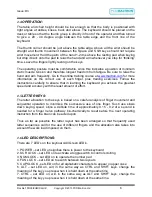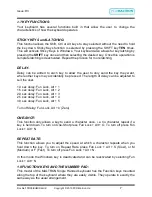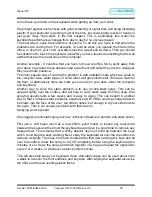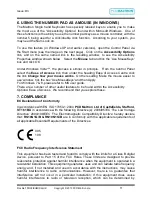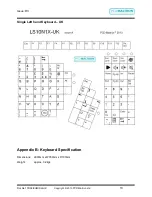
Issue: D3
Doc Ref: 00/08/KUM/SH/UK Copyright © 2013 PCD Maltron Ltd
10
do not have your hand on the keyboard when getting up from your chair.
We protect against such shocks with good screening of signal lines and using insulating
plastic. If your keyboard is working most of the time, but occasionally resets or beeps or
just goes crazy, then static is the first suspect. This is particularly true when the
keyboard's performance changes from day to day for no obvious reason.
The best way to solve the problem is at source. To do this you have to find where the
problems are coming from. For example, it could be when you operate the blinds in the
office, or rise from your chair, or walk across the carpet and sit down. Then you should
be careful not to touch the keyboard until after you have touched something that is well
earthed such as the metal case of the computer.
Another example - it could be that you have to move an office fan to point away from
your desk. In general, these options need experiment and whilst they are the cheapest,
they need more patience.
The most popular way of solving the problem is with antistatic mats which are wired to
the computer case, water pipes, or some other well grounded metal. There are mats for
the floor, or alternatively there are mats you can use on your desk under the computer
and keyboard.
Another way to solve the static problem is to use an anti-static spray. This can be
sprayed lightly over the surface and will help to carry static away from the area. One
spraying usually lasts a few weeks and is easy to apply. This can benefit in another
way in that it reduces static problems experienced with VDUs causing charged dust to
be blown into the face of the user, too little to notice, but enough to dry out skin and tire
the eyes. This is not usually a problem with flat screens.
Spraying your keyboard
We suggest an anti-
static spray such as Johnson’s Sparkle or another anti-static polish.
First use a soft brush (such as a new 25mm paint brush) to loosen any dust down
between the keys and then hold the keyboard up and give it a good blow to remove any
trapped dust. This ensures that a sticky deposit does not build up between the keys
which could stop the keys working. Next, spray the keyboard all over the top surface to
dampen it slightly. Then use the brush to spread the fluid down among the keys and all
over the surface. Allow the spray to dry off completely before using the keyboard (ten
minutes or so). Keep the spray and brush together in a bag and repeat the application
every 3 or 4 weeks, or whenever a static problem occurs.
This will also help keep your keyboard clean. Anti-static wipes can be used about once
a week to rub over the front surfaces and key tops. After wiping the keyboard also wipe
the VDU and the surrounding plastic frame.






